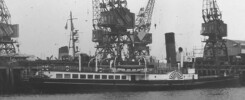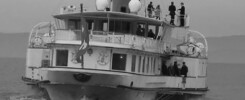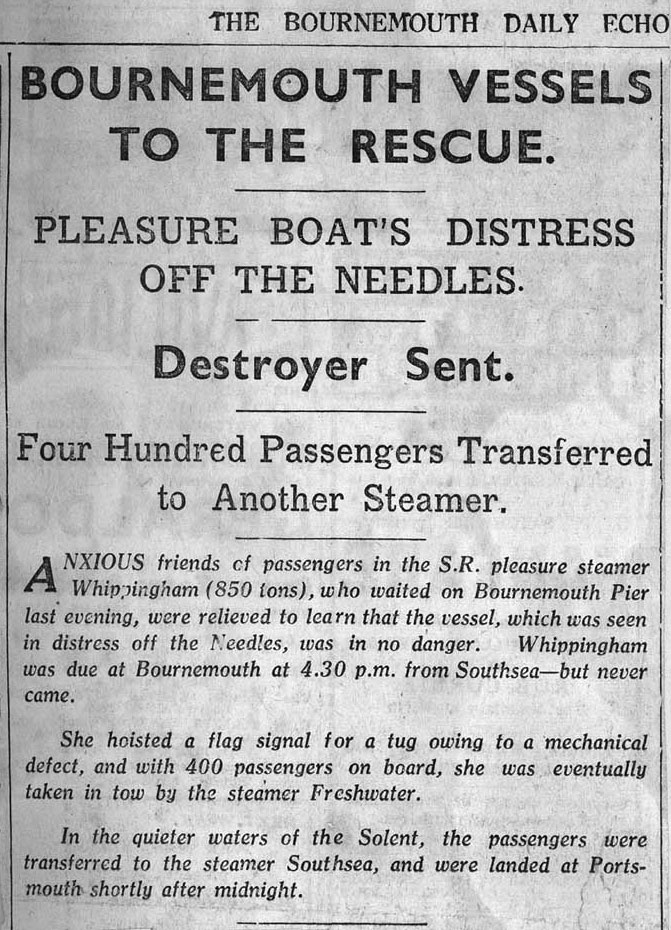
What is particularly surprising about this paddle steamer breakdown, which occurred off the Needles in 1935, is the ship.
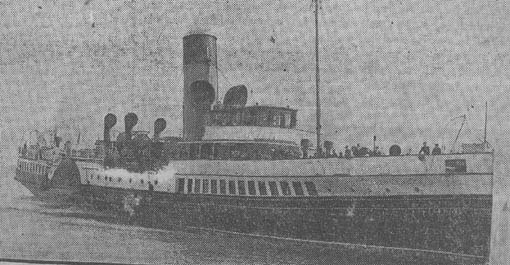
The Whippingham was not some old, clapped out and perhaps poorly maintained steamer from the past but was almost brand new having been delivered from Fairfield of Govan to join the Southern Railway Portsmouth fleet just five years earlier. As such, she was a mere spring chicken compared with the comparatively geriatric paddle steamers from the fleets of her competitors, Cosens and Red Funnel, which sprang to her assistance on that fateful afternoon.
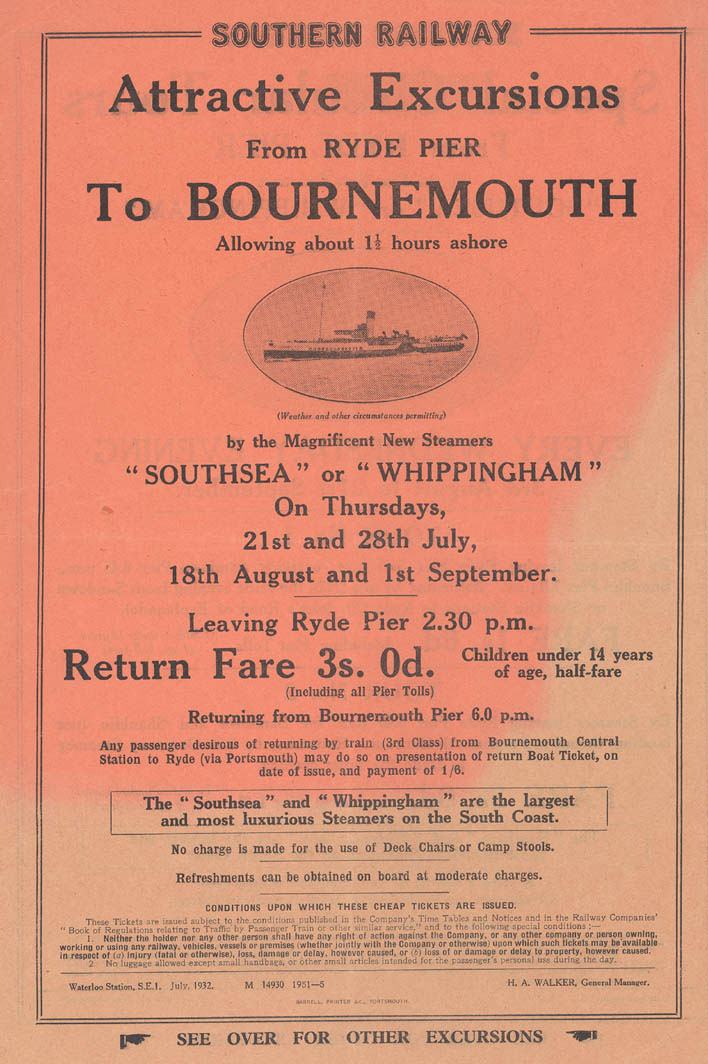
The Bournemouth Daily Echo reported:
Anxious friends of passengers in the Southern Railway pleasure steamer Whippingham (850 tons) who waited on Bournemouth Pier yesterday evening, were relieved to learn that the vessel, which was seen in distress off the Needles, was in no danger. Whippingham was due at Bournemouth at 4.30pm from Southsea but never came.
She hoisted a flag signal for a tug owing to a mechanical defect and, with 400 passengers on board, she was eventually taken in tow by the steamer Freshwater.
In the quieter waters of the Solent, the passengers were transferred to the steamer Southsea, and were landed at Portsmouth shortly after midnight.
The passengers, however, were not landed until frantic dashes to her assistance had been made by a destroyer from Portsmouth, a lifeboat, the pleasure steamers Balmoral and Bournemouth Queen and other vessels.
Bournemouth Queen was slightly damaged when, with Balmoral, she went alongside to take off the Whippingham’s passengers – all in vain, as there was a heavy sea running.
Two other Bournemouth pleasure steamers – the Emperor of India, and the Queen – were also in the picture, one which provided no little excitement for the time being, for it was rumoured that the Whippingham had sprung a leak.
The weather was fine until 4.30pm but it was about that time that Whippingham hoisted her signal. Then there were squalls with a stiffish SW wind. Visibility later became restricted long before dark fell.
Capt J Fields, skipper of the Bournemouth Queen interviewed by an Echo reporter alongside Bournemouth Pier at 7.15 last evening said: “We were returning to Bournemouth from the Island trip and about 5.30pm saw the Whippingham with a flag signal for a tug hoisted. We went alongside with the intention of taking some of her passengers off but it was impossible due to the swell. Our starboard paddle box was slightly damaged. We came in and landed our passengers and we were going back with the intention of rendering assistance if possible. Bournemouth Queen eventually returned to Poole about 10pm.”
Commander Moss, piermaster at Bournemouth said: “I saw Whippingham lying off the Needles. She was due here at 4.30pm but appeared to be held up. I got in touch with the dockyard at Portsmouth and, in the meantime, the pleasure steamer Queen, which was on the Swanage service, was kept alongside the pier here.”
“Later Portsmouth informed me they were sending a destroyer to Whippingham and I told them that Balmoral, Bournemouth Queen and Emperor of India, all three of our ships on the Island trip were in the neighbourhood. Queen did not go.”
After standing by the distressed steamer for about 20 minutes on his way back from the Island trip, the SS Balmoral’s captain decided to resume the journey to Bournemouth to disembark his passengers and then to return post haste to the Whippingham to stand by again.
The last passenger had scarcely left the ship alongside Bournemouth Pier before the gangways were withdrawn and the Balmoral had set out to sea again.
A Bournemouth passenger on the Balmoral – Mr H P Remington of 10, Tennyson Road, Moordown – told the story: “We left Cowes at 3.50pm and came across Whippingham, which had hoisted distress signals. There was a large number of passengers aboard her and we were told that her engine had broken down.”
“The Yarmouth lifeboat was already standing by when the Balmoral arrived. We continued our journey to Bournemouth leaving the Bournemouth Queen standing by.”
Mr Remington explained that the Whippingham had anchored and was waiting to be taken in tow,
There was some excitement among the passengers on the three Bournemouth steamers, particularly Balmoral – which was scheduled for Cherbourg yesterday but did the Island trip owing to the weather – and Bournemouth Queen although many passengers below decks in the Emperor knew nothing of the Whippingham’s trouble.
The London contingent of the 400 passengers , who had left Portsmouth yesterday afternoon in the Whippingham on a trip to Bournemouth arrived at Waterloo early today, tired and hungry after their ordeal.
Many of them presented an unhappy, miserable spectacle and babies sound asleep in their parents’ arms gave a poignant touch to the scene. Other children who still managed to keep awake walked quietly by their parents’ side. “A sad ending to an unhappy day” said one man.
The Echo was officially informed by their owners at Southampton that the Balmoral was undamaged. The Bournemouth Queen was very slightly damaged on the paddle box. The company’s tug Clausentum went to the scene but her services were not required.
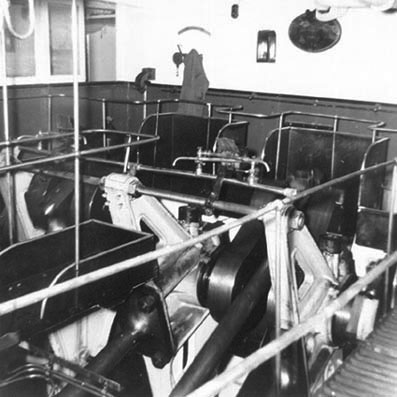
This report was written by the Bournemouth, note the word “Bournemouth, Daily Echo” and so, not surprisingly, it reflects this incident from the Bournemouth perspective showing the Bournemouth Boats in a particularly favourable light compared with the foreign interloper from Portsmouth: Whippingham.
Note that the article is headed: “BOURNEMOUTH VESSELS TO THE RESCUE” in the biggest type of all. And that the main body of the text lays it on thick about how much assistance was being provided by the Bournemouth Boats even though it was none of them which actually rescued the Whippingham in the end.
Of course what they did in standing by and offering assistance was absolutely the right thing to do. Who knows if things might not have taken a turn for the worse. And the rumour mill was cranking things up with the wholly inaccurate suggestion that the Whippingham was leaking.
However, Whippingham does not appear to have been in any immediate danger. She had her anchor down. And, very sensibly in the circumstances, her captain avoided any claims for salvage from the rival fleets by waiting for one of his own company’s ships, the paddle steamer Freshwater, to tow him back into the Solent and for one of his own company’s ships, Whippingham’s identical twin sister Southsea, to take the passengers off. Good thinking captain!
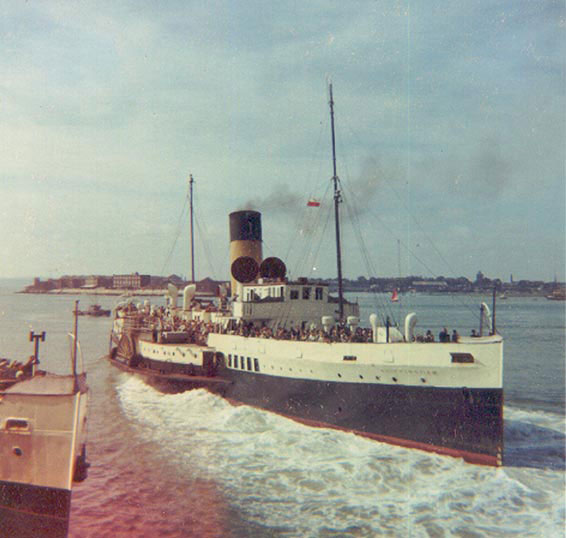
Whippingham continued in the railway service from Portsmouth until 1962 although in later years she became very much the spare boat coming out for the ferry service to Ryde only on busy days in the peak summer weeks.
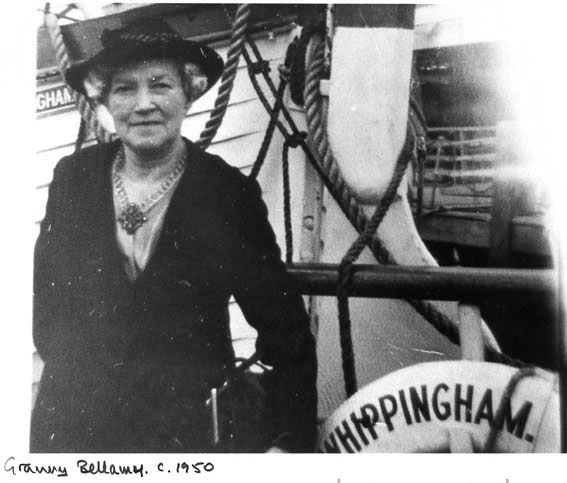
And as a nice link from the September Pictures of the Month about paddle steamers at Bournemouth in the 1920s which featured Mike Ledger’s grandmother, Fanny Bellamy, he has sent in another picture of her taken aboard the Whippingham in the early 1950s. Fanny may be thirty years older and a grandma but she was still sailing aboard paddle steamers and, seemingly, still wearing the same hat – an example to us all!
Whippingham was scrapped in Ghent in 1963, thirty three years after she was built and twenty eight years after her little excitement off the Needles in 1935.
Kingswear Castle returned to service in 2023 after the first part of a major rebuild which is designed to set her up for the next 25 years running on the River Dart. The Paddle Steamer Kingswear Castle Trust is now fund raising for the second phase of the rebuild. You can read more about the rebuilds and how you can help if you can here.
John Megoran

